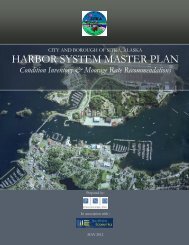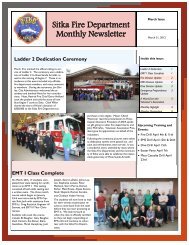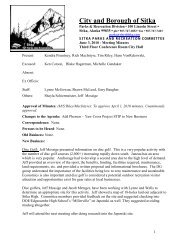final Sedimentation Report - City and Borough of Sitka
final Sedimentation Report - City and Borough of Sitka
final Sedimentation Report - City and Borough of Sitka
Create successful ePaper yourself
Turn your PDF publications into a flip-book with our unique Google optimized e-Paper software.
volume <strong>of</strong> sediment deposition <strong>and</strong> erosion in the Expansion-related Blue Lake Creek delta; <strong>and</strong><br />
evaluate probable fish habitat <strong>and</strong> accessibility in the future Blue Lake Creek fluctuation zone.<br />
An estimated 667,000 cubic yards <strong>of</strong> cobble/gravel/s<strong>and</strong>/fines has been deposited in the current<br />
Blue Lake Creek delta over the 52 years since current Project operations began. Delta deposits<br />
were estimated to range from at least 15 feet deep near the head <strong>of</strong> the delta to 2-3 feet deep<br />
deposits <strong>of</strong> fines along the margins <strong>of</strong> the active channel area. The median length <strong>of</strong> exposed<br />
channel under current operations during the May-July spawning season is 200 feet in May <strong>and</strong><br />
June <strong>and</strong> 10,100 feet in July as reservoir level rise through this time period. Stream gradients at<br />
three measured transects ranged from 0.016 to 0.020, with bankfull widths <strong>of</strong> 63-240 feet, depths<br />
<strong>of</strong> 1.38 to 3.07 feet <strong>and</strong> armor layer D50 ranging from 1-34 mm.<br />
The extent <strong>and</strong> depth <strong>of</strong> delta deposits following 50 years <strong>of</strong> proposed Expansion-related<br />
operations was estimated based on valley width <strong>and</strong> gradient conditions in the current vs.<br />
proposed fluctuation zone assuming a similar rate <strong>of</strong> sediment input. It was assumed that the<br />
active channel in the Expansion delta would be similar to the widest measured transect in the<br />
existing delta, with stream gradients ranging from 0.005 to 0.01, similar to the existing delta <strong>and</strong><br />
stream channel. Delta deposits were estimated to be 2-10 feet deep across the new delta.<br />
Under modeled expansion conditions, the median length <strong>of</strong> exposed Blue Lake Creek bed<br />
decreases from 7,200 feet in May to 5,200 feet in July. This suggests that a longer length <strong>of</strong> Blue<br />
Lake Creek would be accessible to rainbow trout in Blue Lake during the spawning season under<br />
Expansion operations than under existing conditions. Assuming a wide (240 ft bankfull width)<br />
low gradient (0.005) channel would exist in the Expansion delta, water depths during migration<br />
<strong>and</strong> spawning were computed to range from 0.8-1.2 feet under 25-50% exceedence flows during<br />
the May-June-July spawning period which should not inhibit upstream migration <strong>of</strong> rainbow<br />
trout. It is possible that some areas <strong>of</strong> the new channel may be wider <strong>and</strong> braided than the<br />
modeled cross section, but there are wider, low gradient, braided areas within the downstreammost<br />
portions <strong>of</strong> the existing delta stream channel that do not appear to impede migration under<br />
existing conditions.<br />
Estimated shear stress under the modeled Expansion-related channel hydraulic <strong>and</strong> flow<br />
conditions during May-June would result in entrainment <strong>of</strong> particles in the 8-16 mm size class at<br />
the average water depths. It is expected that, similar to the existing delta channel conditions,<br />
substrate within the deepest portion <strong>of</strong> the new delta channel would be larger than that on the<br />
margins <strong>of</strong> the channel <strong>and</strong> would provide a mix <strong>of</strong> substrate across the channel. These size<br />
classes are within the range preferred by spawning rainbow trout, suggesting that there would be<br />
spawning habitat available within the Expansion delta stream channel.<br />
Future sediment deposition <strong>and</strong> spawning habitat were considered for Becky, Brad <strong>and</strong><br />
Sheldon Creek with the limited data available. Expansion related spawning conditions will<br />
be similar to those encountered during 2005 relicensing studies (CBS 2005, Wolfe 2009).<br />
During this time spawning was concentrated along shorter lengths <strong>and</strong> in the case <strong>of</strong> Brad<br />
Creek along a steeper gradient. With the exception <strong>of</strong> Becky Creek, all future spawning<br />
will take place at a gradient that was initially less then that where spawning occurred at<br />
Brad Creek in 2005.<br />
Blue Lake Reservoir <strong>Sedimentation</strong> <strong>Report</strong> 30 Blue Lake Project Expansion<br />
Watershed GeoDynamics FERC No. 2230<br />
December 2009








